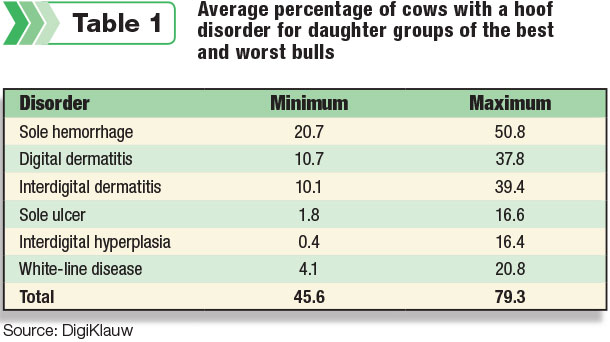Hoof problems are the bane of many producers’ existences. Lame cows eat less, fail to achieve optimal production and are more prone to other issues, such as ketosis and reduced fertility.
Treating them is both time- and labor-intensive, and the outcome is often uncertain.
The good news is: Vulnerability to poor hoof conditions can be reduced with genetics. With the help of breeding values and utilizing hoof health indices, it is possible to select and breed for good hoof condition – creating more profitable and manageable herds.
Big differences between daughter groups
Many hoof health problems can be avoided with balanced nutrition, comfortable housing and good management. But the basis of healthy hooves lies in selective breeding. In practice, there are significant differences between daughter groups’ susceptibility to hoof problems.
Table 1 summarizes disorders such as sole hemorrhage, digital dermatitis, interdigital dermatitis, sole ulcer, interdigital hyperplasia and white-line disease. The difference in incidence of sole hemorrhage, digital dermatitis and interdigital dermatitis in daughter groups of the worst and best bulls is approximately 30 percent.

This shows that susceptibility to hoof problems has a large hereditary component – proving that using genetics indeed reduces these incidents.
Index makes breeding simple and herd profitable
Genetic indices make it easy for farmers to choose and breed for fewer hoof problems and to measure the direct economic value. Data from thousands of observations by professional hoof trimmers are used to calculate breeding values for key disorders. Data is also weighted based on their financial impact to the producer and combined to make a hoof health index.
A highly resistant herd is easier to manage and converts feed into milk more efficiently.
Descendants of a bull with an index of 108 will have an average of nearly 6 percent fewer hoof problems per year. This gives an improved return of nearly $13 per cow by improving the hoof health of daughters of a bull with an index of 108.
“Healthy hooves are vital when you’re a family business that needs to milk highly productive cows easily and efficiently,” says Dutch dairy farmer Jochem van der Starre.
He does all the work on his animals’ hooves himself and trims them preventively before they go dry and 100 to 120 days after calving. “I record any problems and keep an eye on the health of their hooves and adjust my management if necessary. Afterwards, I have an objective test of whether the changes have the desired effect.”
Hoof health is an important breeding objective
Records from farmers like van der Starre are used to calculate breeding values for hoof disease and support genomic breeding values. “With a trait like hoof health, genomic selection can play an important part in genetic improvement – both in a bull’s breeding program and my own herd,” he says.
“In practice, there are significant differences in inherited hoof health. One bull’s daughters can be much more sensitive to specific problems than another’s.”
Van der Starre uses hoof health breeding values when selecting bulls he uses to grow his herd. “I want to create efficient animals that give lots of milk easily, and hooves are an important factor in achieving this efficiency. Selection and breeding play a key role in this process.”
Breeding for healthy hooves is an opportunity
Prior to becoming a genetic consultant, I worked for a company selling footbaths and other dairy equipment and studied hoof health of thousands of cows. It did not take me long to realize the huge impact hoof health had on cow performance – particularly in freestall barns.
Hoof problems cost farmers time and money – two resources they can’t afford to lose. Preventive measures such as footbaths help in theory. But, in practice, they’re often not carried out properly, so do not have the optimal effect.
Dairymen should take hoof health into consideration when choosing the right genetics for their herds. It truly is a unique opportunity to create a herd that’s easier to manage and generates a higher return for the farmer. PD
PHOTO: Using bulls with a hoof health index of 108 improves the final return from better hoof health by an average of $13 per year. Photo courtesy of CRV.
Harold Wheeler is a genetic consultant with CRV.





